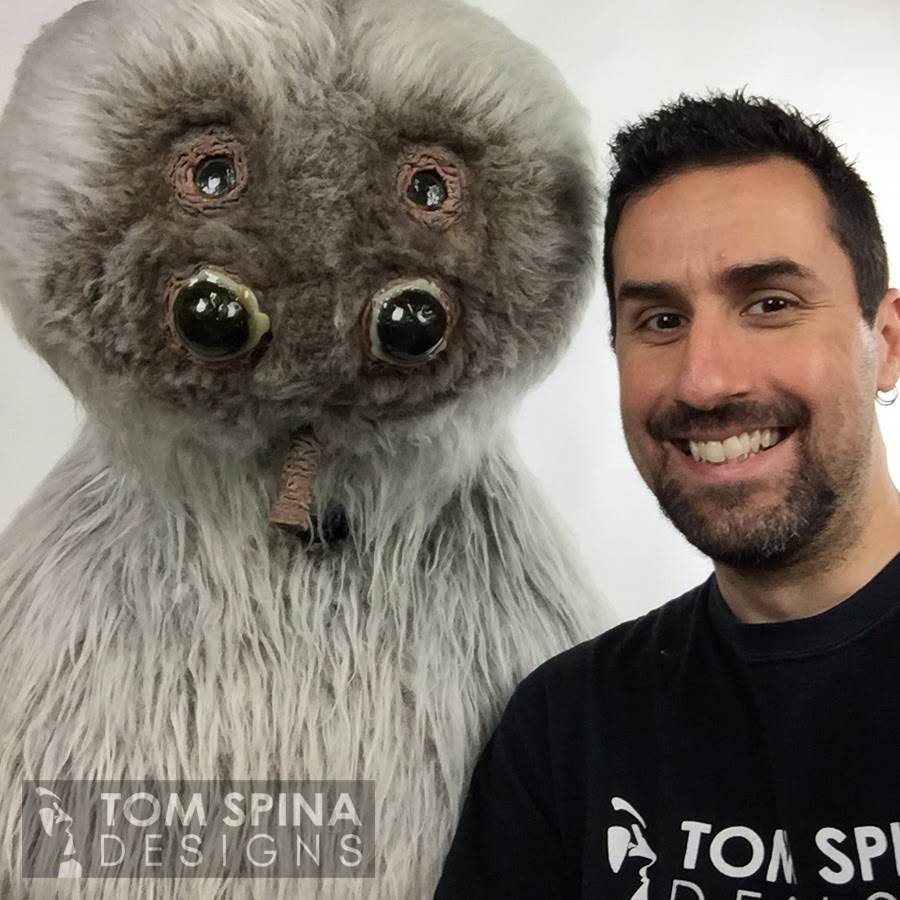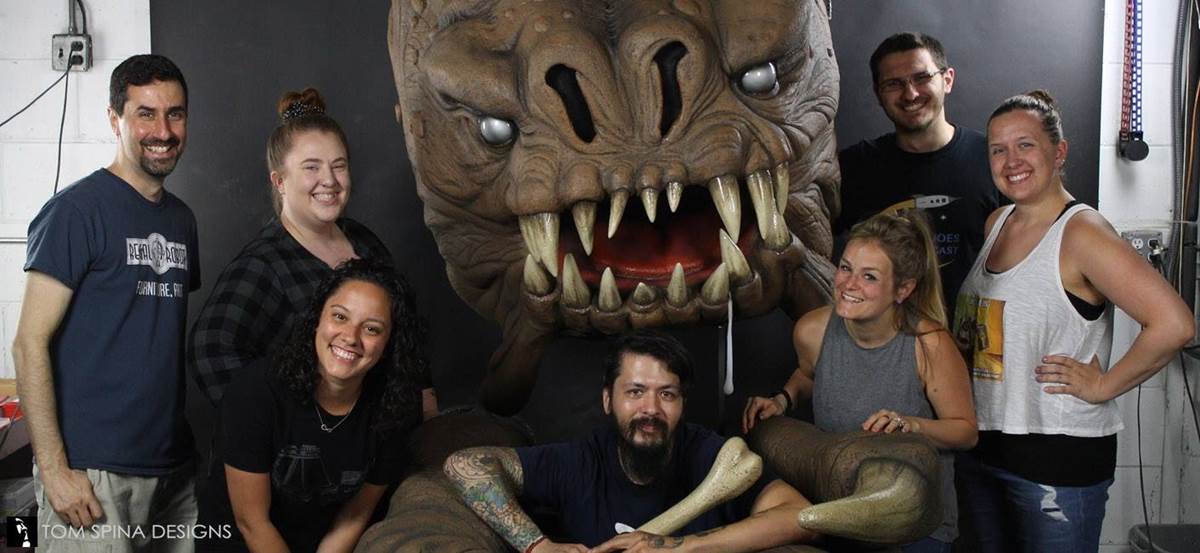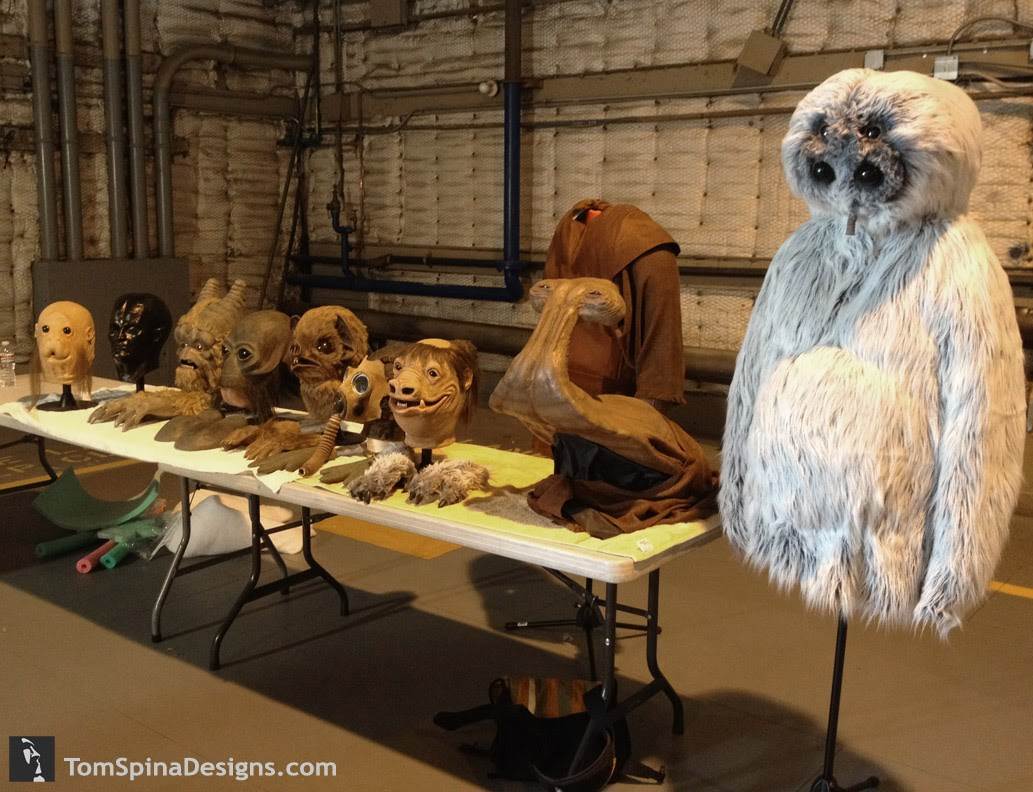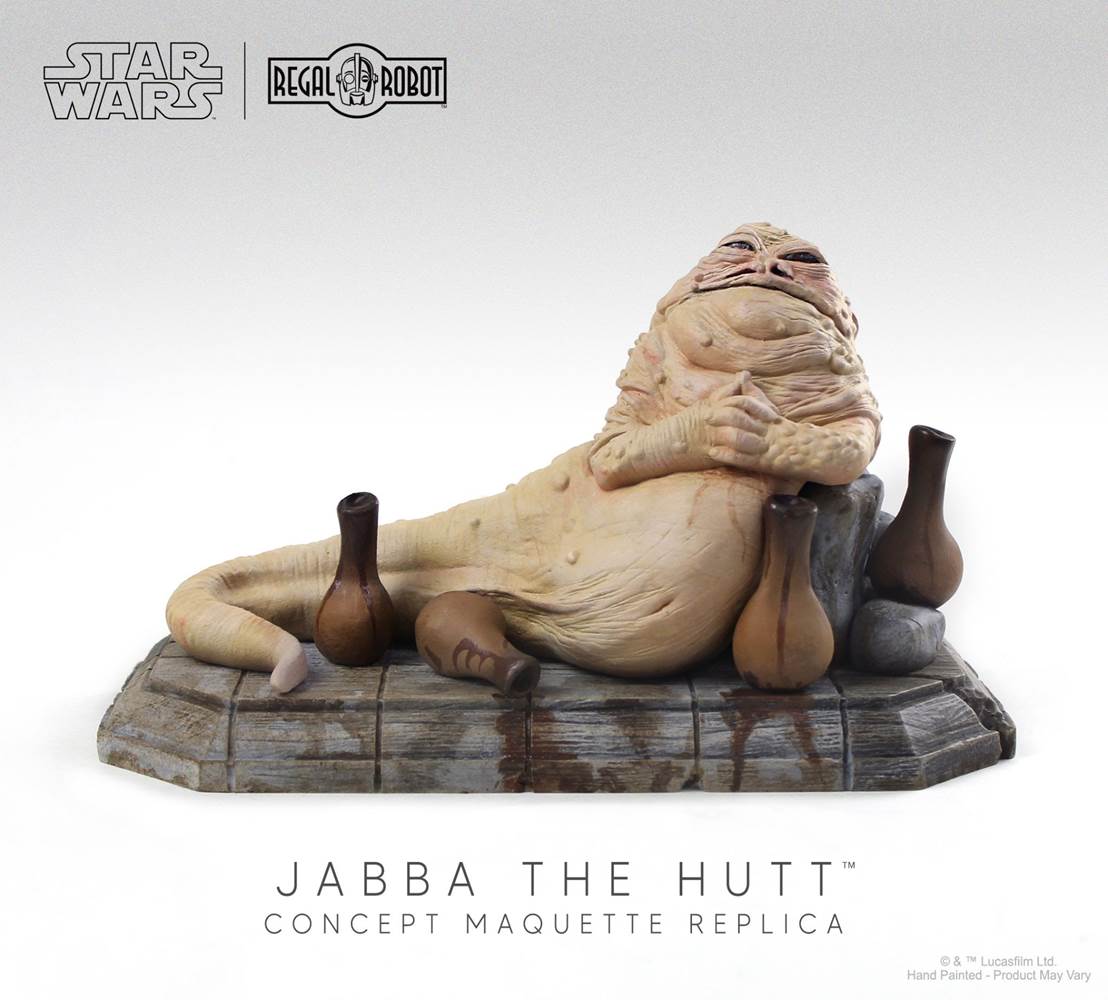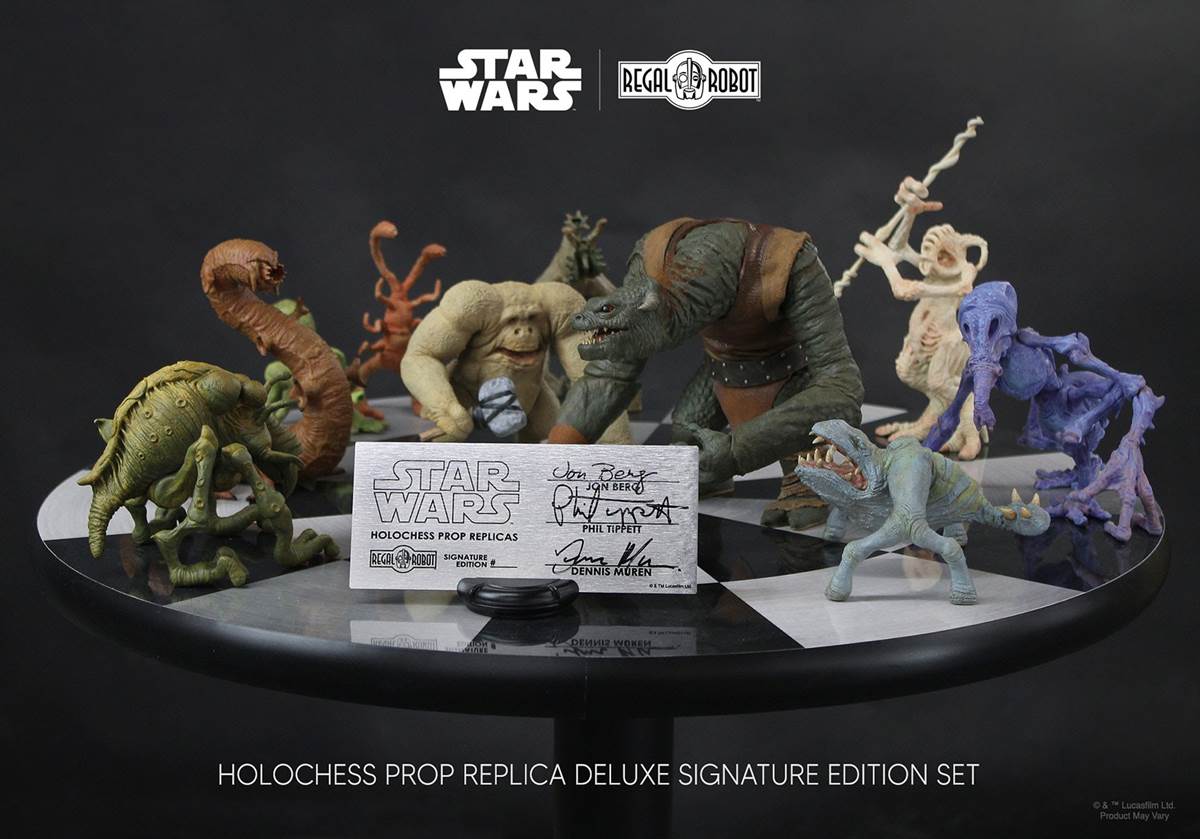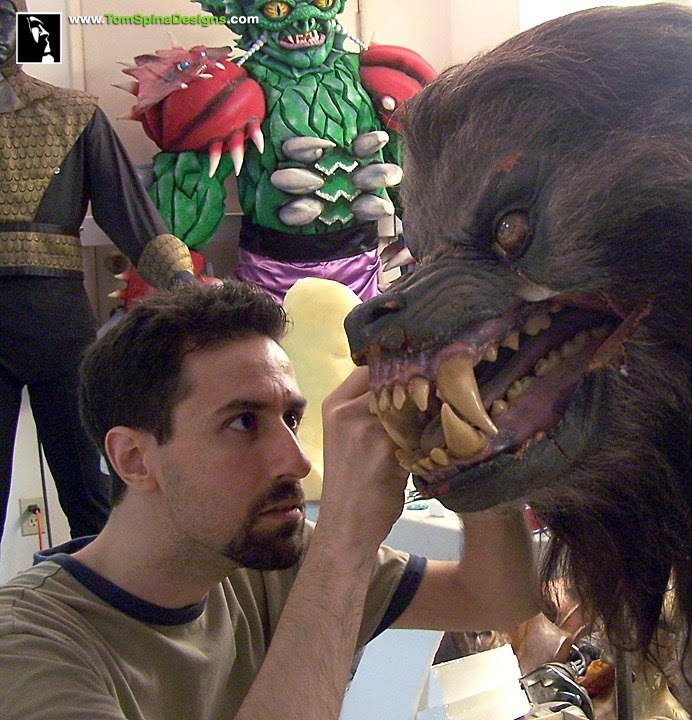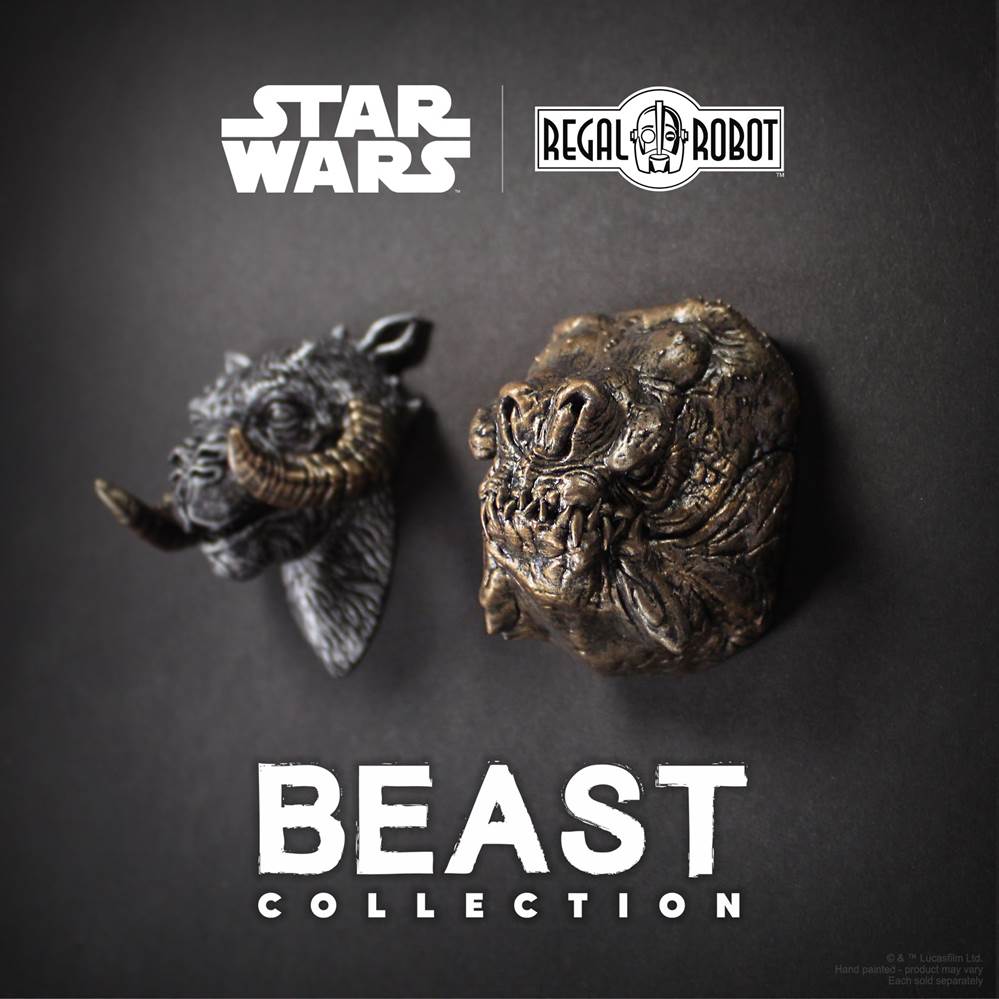Interview: Catching Up with Regal Robot Founder Tom Spina at the Company’s Long Island Headquarters
In the Spring of 2020, I interviewed Tom Spina-- founder of the themed furniture and collectibles company Regal Robot-- over the phone about his Star Wars history and The Mandalorian tie-in products. And this month, during a trip home to visit family, I had the amazing opportunity to stop by for a tour of Regal Robot’s headquarters on Long Island, where I saw many amazing things being worked on that I’m not allowed to talk about.
However, during my visit, I was able to sit down with Tom Spina for a nice long conversation about Regal Robot’s latest output, his experience growing up as a Star Wars fan on Long Island, and the custom restoration work he does under Tom Spina Designs.
Mike Celestino, Laughing Place: How did your businesses end up here on Long Island? And are you from here originally?
Tom Spina: Yeah. And the answer to the first question is the answer to the second. My whole family is from here. And it's the sort of thing where I set about trying to do really anything in the industry-- I just wanted to be in TV, in movies, in whatever I could do. I would've gladly swept the floor at any special effects studio or makeup department, and ultimately I got a gig with The Muppets for my internship in college. That showed me, ‘Hey, you know what? New York's still pretty happening, there's a lot of good stuff going on here.’ I interacted with a ton of great people and realized that that's an avenue. I was into puppetry at the time. I built a small puppet company here, eventually found my way to the technical side of TV-- working in New York as a technical director.
And all the while [I was] learning about makeup effects, learning about sculpting, learning about making monsters-- exploring all this stuff that was my passion since I was two years old. It's funny-- as an inventive sort, as a creative sort, I feel like there's an element of, ‘I couldn't find the job I wanted so I invented one.’ If I had told my high school guidance counselor, ‘I'm going to restore movie props for a living.’ That wasn't a thing. That wasn't on the career poster that they had. But it wound up being a thing. It wound up being something that connected with a lot of folks, and that I really had a knack for, and that gave me something to really explore and build a business around. We were doing something unique. All the other stuff we do-- the sculpture, the big event stuff, the big foam props and things like that, trade show stuff, costumes, monsters, et cetera-- that's all stuff that other shops can do. When it came to preserving history-- preserving these artifacts of the films that we love growing up-- there weren't a lot of options for that. Diving into that gave me something to really sink my teeth into.
I voraciously ate up anything I could about museum techniques and preservation, as well as the effects side of all of this, and tried to find, ‘Is there a marriage of these two? Is there a way to preserve movie stuff with the caution of a museum conservator, but with the artistic sensibility of a movie effects guy?’ which is really what I was at heart. And it turns out that that peanut butter and chocolate went together pretty great. So now you see what we've got here.
LP: Last time you told me that you were five years old when the original Star Wars film came out. Growing up on Long Island, what was the atmosphere around the movie in that era? Did you feel it was a mainstream thing?
Spina: It definitely was. I don't know though. All the kids I was around were obsessed with it. The difference between me and most of the more normal kids [was] where they all wanted to be Luke Skywalker or Han Solo or Princess Leia, I wanted to be Stuart Freeborn, or Jon Berg, or Phil Tippett, or Rick Baker. I had no idea who any of them were, but that's what I wanted to do. Even as a kid, I wanted to remake Star Wars. I wanted to explore that galaxy, and make movies in it, and learn everything I could about how this happened. Luckilyy enough, they did some great TV specials that I absolutely owe my livelihood to. They made The Making of Star Wars, The Making of The Empire Strikes Back, From Star Wars to Jedi: The Making of a Saga, Classic Creatures: Return of the Jedi... all of those. I watched them any chance I could. We were lucky to have a couple of mom-and-pop video stores around where you could find stuff like that sometimes.
I would rent those more than I would rent the movies. But yeah, it was everywhere. It was ubiquitous. Whether it was your buddy, or someone's older brother, someone's younger sister-- everybody wanted something from Star Wars. It was really a cultural movement. And that's through the eyes of a five-year-old, but I feel like it's pretty accurate.
LP: What has your relationship been with Star Wars in more recent years? Have you kept up with all the content that's come out in the past couple decades?
Spina: It's tough to keep up. There is a lot. I haven't been as good about keeping up with the books and things like that. Unfortunately, that's just down to never having a moment of spare time. I've kept up with all the films, all the TV shows. The prequels were a huge deal when those hit. It was an interesting time to be an older Original Trilogy fan. I remember seeing The Phantom Menace [in 1999], and it took a few views to click into what was going on with this new trilogy, because it felt so different at the start. It's interesting-- my views on the prequels [have] really changed over the years. I remember I had it in my mind when they came out that they were getting better as they went on. And I view them the reverse now. But that's just a pure personal opinion. It's interesting to go back and watch them, knowing more about how they were made. Here's the good thing: there are so many movies that have come out over the years that have an amazing creature, or have an amazing set, or have a brilliant art direction, or have costumes that blow your mind-- but you just don't connect with the story.
There's tons of stuff like that for me. What I find is, no matter what there is in Star Wars, whether the movie fires on all cylinders for you, [or] it fires on some, there's something you're going to take away from it that you're going to love. As being somebody who's passionate about the making of these movies-- for everything Star Wars-- that's an amazing thing to get into. The making of those movies is fascinating-- the boundaries they were pushing. Even on the CG front, it's fascinating to me. Even if that's not where I ultimately ended up, I find that stuff amazing. And to then come now to the sequel trilogy and the new TV shows-- to see what they're doing the new movie costumes are just outstanding. And their particular take on the props, their particular take on the creatures-- the level of detail and quality and realism in the creatures for these new movies is off the charts. And on the story side of it, some of them I feel great about, some of them I feel less great about. Some of them I watch all the time, some of them I don't watch as much. But I think that's [the same with] everything.
LP: Let’s go through some of the recent output from Regal Robot, starting with the CZ-3 bust. This is a pretty obscure character. Where did the idea come from to make that?
Spina: He's my favorite droid. You see him briefly in the sandcrawler, you see him shambling through Mos Eisley’s streets, and you see him in the background of Jabba's Palace twice-- once in pieces and once just walking around. This to me is the magic of Star Wars: that you can have Darth Vaders and stormtroopers and main characters that people can enjoy and love, but then have this wonderful tapestry of stuff in the background. You can just pick out something interesting and dial in on it. Even as a kid, there was something about CZ-3 that probably frightened me a little bit, and also fascinated me. He looks weird, he's kind of cross eyed, he has a pinched face with a nose like a shrew, and this oblong-shaped head. He's asymmetrical as anything.. Maybe [I like him] because he's so weird. You can almost feel a little ownership. You can go like, ‘Well, all right... everybody else has [the other characters], but he's mine." That's the feeling that some of these background characters give folks. I'm obsessed with weird stuff in the background of Star Wars.
LP: What do you find is the response when you dig up an obscure character like that?
Spina: It definitely was a bunch of people going, ‘Why aren't you making C-3PO?’ And I go like, ‘Well, Sideshow Toys makes C-3PO.’ They exist, therefore we can do the more fun stuff. It's always an interesting reaction. The other thing is, we bring a lineage and authenticity to all the stuff we do. When we do a character like CZ-3, we go to [the Lucasfilm] archives, we examine the real prop... in the case of CZ-3, we actually scanned that whole thing from head to toe. Because once you have the scanner out, you might as well do the whole body, because we do custom stuff. There's always the chance that someone comes out and says, ‘I saw you did a bust of this, can you do the whole thing?’ And it was one of these things where I think a lot of people gained an appreciation for CZ-3 after seeing our bust. He's cool, [and] he is so 70s, too. Even though he does turn up in Jedi, there's something very first-movie Star Wars about him. It's like that first-movie Vader versus the Jedi Vader. When you compare those two helmets, they're night-and-day in terms of the style. I always gravitate towards that first look. I always gravitate towards the thing that made that first connection with me, and there's something about CZ that just connects me back to that Sandcrawler.
LP: You did a maquette of Jabba the Hutt, you've done the Rancor statue, and then most recently you have a full-size statue replica of the original Salacious Crumb puppet. Tell me a little bit about these.
Spina: [For] The Rancor, we did a similar thing: we scanned the original prop from the archives, we digitally restored it to turn back the hand of time a little bit, but trying not to leave too much of our own fingerprint on it. We wanted to make sure we were maintaining that-- just being as faithful as possible to that original puppet, which is always really our push on all of this stuff. That's a thread I'm sure you've seen run through everything we're making. But the Rancor sold out in a day and a half. There was a very big appetite for it. That resonated with people a lot, and it was really cool to see. It gives you this great sense of satisfaction, because this is the stuff I'm obsessed with personally. Yes, it's a business, but I am emotionally invested in making stuff a certain way. I feel like if I can stay true to that, and I can do the stuff that I know just makes me happy, then this is going to make some other people happy too.
That Jabba the Hutt, that was made using a digital recreation of the original maquette that Phil Tippett sculpted, that I first saw in From Star Wars Jedi: the Making of a Saga. I always loved the sense of character it has-- it's got its hands clasped on his belly, he's got jugs of foul-smelling liquid around him, one assumes, tipped over and spilled. He's leaning against this big stone piece. And it's just a very Phil Tippett sculpture, too. There's a lot of character in it. It's more than a creature; it's a character-- and that's the stuff that really resonates with me. We're going to be doing a lot more of those maquettes. We have plans for quite a few of them. What I like about those is the price point is good, the edition sizes can be a little bigger, we can be a little more accessible to some more folks, and it's this great connection to the making of these movies. It's more than just another statue of a character that maybe you have five action figures of already. We want to give people something special.
Salacious was 150 pieces, which is the biggest edition on something of that scale that we've done. We had to put a lot of engineering into how we were going to make it, because we make everything by hand to maintain the kind of quality that we want. We want each of these to be an art piece. We want people to get something that is one-of-a-kind, unique, and specific to them. They're not getting one of 10,000 things that came off of a machine; they're getting one of 150 things that a handful of people put together with a bit of love and care for them. Salacious managed to sell out in about 48 hours, and it's a cool feeling. It’s just so great to see that many people excited to bring this thing into their home. That's what speaks to me. I'm a collector. I know what it feels like to see something and go, ‘I've got to have that.’ And I know how cool that feeling is when you get it. I know that's a big thing, so it means that much more to me every time someone clicks that ‘Buy’ button.
LP: The last specific piece I want to talk about is the Dejarik or Holochess characters. This must have been on your list of things that you wanted to tackle for a while, right?
Spina: It was something I was mildly obsessed with years ago. It's a tough thing to mass produce, because it's such a niche item-- especially doing it the way we wanted to do them, which was the scale of the real puppets. They're just big and chunky and cool, and every one of them is a totally different design. It looks like ten different people sculpted these things-- turns out it was just two: Jon Berg and Phil Tippett. And luckily I knew both [of them] and Dennis Muren, who shot the scene. I was at Phil's shortly before they were shooting Solo: A Star Wars Story, and they were prepping the figures to put into [the movie], because they were going to do another scene with it. And the attitude was, ‘Do you want to play with them?’ I was like, ‘Yes.’ That tactile connection there, even if these are the 2015 interpretations of it, something about it just went off in my brain. It was like, ‘These are amazing. I have to have these.’ And it really just sat in the back of my rain for a long time. I wasn't sure it was something we could pull off for Regal Robot.
It really was a bunch of things coming together at the same time. It was an increase in the digital technology that was happening [and] it was Phil giving us the access to the digital scans that they had done of the original puppets when they were making them for The Force Awakens. All of that made it something where now we weren't just doing some interpretation of it-- we were doing the pieces. We were able to do [something] that had lineage back to those original pieces that they scanned [and] to the guys that made them for the movie. To get Dennis and Phil and John to sign the plaque for it [was] just so exciting.
It was a nine-month-long process just to get that to the point where we could take our photos and start selling them. So much work went into those. We were trying to nail the scale of every single one of them perfectly. We went back and forth over those things.
LP: What are some of the most unusual, surprising, or challenging custom requests that you’ve tackled over the years with Top Spina Designs?
Spina: With TSD, we cast a much wider net. That's a company where we do restoration of original props and we do sculpture-- that could be anything from bronzes, to wax figures, to creatures and characters, [or] costumes. We [also] do custom mannequins to display original costumes from films, which is a much more challenging task than you might think. Adam Savage coined the phrase, ‘Exploration of an infinite number of possibilities.’ That's what most of the work with TSD feels like. When you're dealing with restoration, that is such cautious and challenging work. Every project that we've done that's restoration is a challenge in some way. When you talk about some of the more interesting or crazy ones, a lot of times that comes down to timeframe. If you're doing something that's going to be in a commercial or a show or an event, it seems like most people wait until the day before to ask you to do it. We did a Super Bowl commercial with a bunch of Star Wars aliens in it, and we got the official go-ahead three weeks before they shot, which for us was nuts. But you just come in, you stay all night, and you work your butt off. You're like, ‘We're going to make Star Wars aliens for the Super Bowl, so we're just going to do this now.’
We built a 20 foot bust of the Statue of Liberty a few years back. It's taller than the building. We had to build it in sections, laying down inside, and then take it into the parking lot to assemble it, to test if everything worked. That was crazy. We built that in 12 days. Stuff like that is hard to put into words. It's really cool when you get to stand next to this giant thing that you and a handful of people have built, but to envision doing that ahead of time is sometimes very daunting. Otherwise, restoring the original wolf from An American Werewolf in London was a huge challenge because I had to do it remotely. But it was the thing that actually connected me with Rick [Baker], who is my idol of idols. Again, [at] five years old [I] didn't even know who he was, but I knew I wanted to do what he did. To be able to fix this thing that won him the first makeup Oscar, and then for that to be the thing that led to a friendship with Rick-- it's hard to put into words how much that means. [It’s] just one of those projects that stays with you.
LP: Lastly, outside of the stuff we've already touched on, is there anything that you want to highlight coming out of either company?
Spina: For New York City Comic Con, we are doing a Comic-Con-from-home kind of exclusive. We've got a new magnet that's coming out that's the last of phase one of our Beast collection, and the only way to get it is during the weekend of that show. You can order it online, I believe it's the 7th through the 10th of October. We also have another series of magnets that's starting up right after that. The first one we're going to release at the same time, and it'll be a real neat transition-- it's a series I've wanted to do forever. Lucasfilm was always a bit resistant. People will probably understand why once they see it, but I twisted their arm, and now I'm making them let us do it, at this point. It's going to be fun.
For more information and to purchase any of the company’s currently available products, be sure to visit RegalRobot.com. And to find out more about Spina’s custom design and restoration work, visit TomSpinaDesigns.com.



